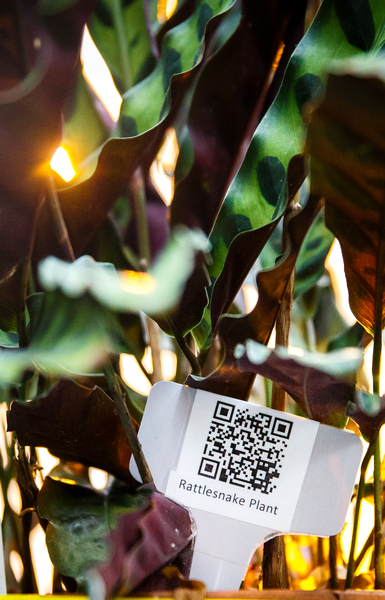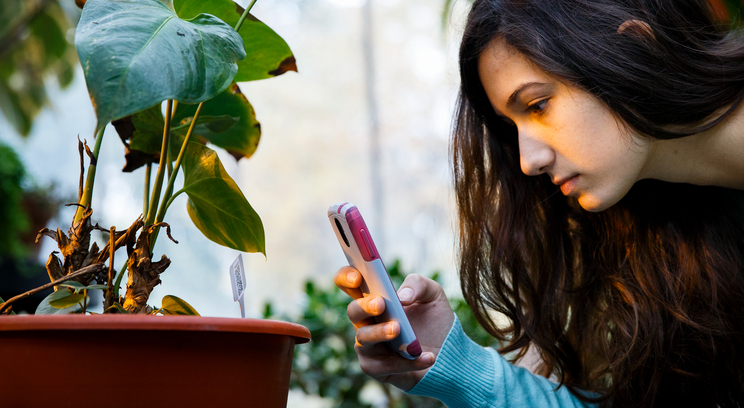If you've visited south campus or the John Roach Center greenhouse lately, you may have noticed a different kind of "foliage" popping up on several of the trees and plants. QR codes, the small square codes typically found in advertising and on postcards, are appearing wrapped around trunks and tucked into pots.
When scanned by mobile devices, the codes unlock a wealth of knowledge about each particular plant – ranging from its origins to its human uses to its temperament. It's all part of a technological experiment dreamed up by a faculty member in the Department of Biology.
The initial idea to tag plants on campus came from professor Dr. Amy Verhoeven, who had noticed the codes popping up all around her in various print materials. "I thought it would be an interesting way to integrate the use of mobile technology, something most people use every day, into plant biology coursework," Verhoeven said.
Before introducing the concept to one of her classes, Verhoeven had to determine whether her idea was viable. She reached out to the Center for Faculty Development and inquired about a Partnership in Learning Grant, a program that allows faculty members to "make progress on a scholarly or pedagogical agenda while providing meaningful educational opportunities for student partners," according to its website.

A QR code in a Rattlesnake Plant. Scanning the code with a smart phone brings up information about the plant. (Photo by Mark Brown)
Verhoeven was awarded the grant and hired Andrew Obrien '13 to "figure it out," she said. "There were a lot of logistical details that I had him work on so that we could implement it this fall." Those details included everything from determining the type of materials used to create the tags to building a website where the information about each plant could be accessible. The initial pilot project launched during spring semester 2013 with admittedly varying success, according to Verhoeven.
"Some of the tags fell off. I think we used bad twine," said Verhoeven, who acknowledged the learning curve involved in the initial tagging. In addition, the UST grounds crew, concerned about aesthetics, allowed the tags to be used on south campus only.
Armed with the information from the pilot, Verhoeven integrated plant tagging into her Plants, Food and Medicine class for the 2013 fall semester. Each student is required to investigate two trees and two greenhouse plants. They then are required to upload their findings to the UST Greenhouse Project website so that each time the code on their plant is scanned, the reader is directed to more information.
For the in-class presentation, most of the students used their own phones to scan the code of the plants to which they were assigned and read their findings right off the screen. There were no printed or handwritten notes.
That marriage of technology into a class that primarily studies the products of nature was important to Verhoeven, who has noticed the prolific use of mobile technology among her students and others. "We are using devices that people are constantly in contact with to help educate them about the plants on campus, playing on their curiosity," Verhoeven said.
The concept was appealing to junior John Pham, who was surprised when he learned of the project but also said it was "awesome. Usually we're told not to use our phones during class."
Junior Kristen Bastug agreed that she enjoyed the unique elements of the project that took them out of the classroom. "It's nice to know that 'lab work' isn't always done in a lab necessarily, that it can mean going out and interacting with plants and technology," she said.
Other residual benefits of the project were felt by senior Rachel Sweet, who said she honed other important skills. "Learning from peers kind of brought us closer as a class," she said of the presentation component, which she said also helped with "public speaking in a small, safe environment," an experience not always available to science majors.
Traffic to the project's website will continue to be monitored throughout the semester to help determine the success of the code placement on the plants. "My main priority is that the students in my class learn a lot about the handful of plants they chose and that the information sticks," Verhoeven said. "And hopefully, through curiosity, others will learn too."
The codes can be found on 20 south campus trees, as well as on plants on display in Owens Science Hall and in the John Roach Center greenhouse.
For more information on the UST Greenhouse Project, visit the JRC greenhouse or any of the tagged trees on south campus and scan the code with your mobile device, or visit the project's website.







